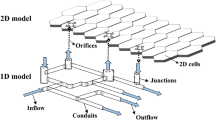Abstract
It is of great significance to study the encounter possibility of typhoon and plum rain in the Taihu Lake Basin in order to adjust the schemes of design storm and utilize flood resource and make the decision of real-time scheduling for flood control in the Basin. Based upon the existing research findings of description of encounter phenomena of typhoon and plum rain, the initial time of typhoon affecting the Taihu Lake Basin, the start time of plum rain season and the end time of plum rain season were selected as the characteristic indices of typhoon and plum rain, respectively. According to their synchronous data from 1954 to 2009, the distribution functions of the above-mentioned three random variables were identified and a formula expressing the encounter possibility of typhoon and plum rain was derived. In view of the complexity and solution of this formula, joint distribution functions of typhoon and plum rain were constructed by the use of Gumbel Copula function on the basis of the adaptability comparison among three functions (Gumbel Copula, Clayton Copula and Frank Copula) in Archimedean functions. For the characteristics of the formula with the joint distribution functions based on Gumbel Copula function, two methods, i.e., numerical integration and Monte Carlo simulation, were selected to solve the encounter probability, and the validity of the computed results was analyzed finally.
Similar content being viewed by others
References
Wu H Y, Guan W Q. 1991 Flood in the Taihu Lake Basin (in Chinese). Beijing: China Water Power Press, 1999. 3–40
Wang J. Climatic characteristics and abnormality analysis of plum rain season in the Yangtze-Huaihe River Basins (in Chinese). Dissertation of Masteral Degree. Nanjing: Nanjing University of Information Science and Technology, 2007. 25–39
Wang T S. Flood Control and Water Resource Management in the Taihu Lake Basin (in Chinese). Beijing: China Water Power Press, 2006. 10–23
Li C Y, Gu W, Pan J. Correlation among plum rain, Arctic oscillation and abnormal circulation of stratosphere (in Chinese). Chin J Geoph, 2008, 51: 1632–1641
Zhu X Y, He J H, Wu Z W. Meridional non-uniform distribution of plum rain and characteristics analysis of anomalous climate years in the Yangtz-Huaihe River Basins. Chin Sci Bull, 2007, 52: 2420–2428
Yao X P, Wu G X, Zhao B K, et al. Research on the dry intrusion accompanying the low vortex precipitation. Sci China Ser D: Earth Sci, 2007, 50: 1396–1408
Fan K. New predictors and a new prediction model for the typhoon frequency over the Northwest Pacific. Sci China Ser D: Earth Sci, 2007, 50: 1417–1423
Chen L S, Meng Z Y. An overview on tropical cyclone research progress in China during the past ten years. Chin J Atmosph Sci, 2001, 25: 420–432
Zhao R H, Jiang J. Relationship between typhoon in the Northwest Pacific and plum rain in the Yangtze and Huaihe valleys, Eastern China. J Nanjing U (Natur Sci), 2009, 45: 365–376
He S X, Fu X Q. On annual variation of plum rain and typhoon and their relationship (in Chinese). Chin J Meteorol Mon, 1982, 18: 8–11
Ren J S. Tropical cyclones from the South China Sea and end of plum rain season in the Yangtze-Huihe River Basins (in Chinese). Chin J Meteorol Mon, 1983, 19: 25–28
Chen Y L, Cao X G. Analysis of influence to strong Meiyu in Shanghai of tropical cyclone and relevant synoptic systems (in Chinese). J Trop Meteorol, 2006, 22: 326–330
Hu S Y. The academic foreland and research demand of hydrology and water resources (in Chinese). J China Hydrol, 2006, 26: 1–4
David K K, Ottis W R. TWODQD: An adaptive routine for two-dimensional integration. J Comput Appl Math, 1987, 17(1–2): 215–234
Wang W S, Jin J L, Li Y Q, et al. Stochastic Simulation Technology for Hydrology and Water Resources (in Chinese). Chengdu: Sichuan University Press, 2007. 20–37
Cong S Z. Probability and Statistical Methods in Water Science and Technology (in Chinese). Beijing: Science Press, 2010. 53–65
Roger B N. An Introduction to Copulas. Berlin: Springer, 2006
Genest C, Anne-Catherine F. Everything you always wanted to know about Copula modeling but were afraid to ask. J Hydrol Eng, 2007, 12: 347–368
Frees E W. Regression Modeling with Actuarial and Financial Applications. New York: Cambridge University Press, 2010
Wong G, Lambert M F, Leonard M, et al. Drought analysis using trivariate Copulas conditional on climatic states. J Hydrol Eng, 2010, 15: 129–141
Genest C, Bruno R, David B. Goodness-of-fit testing for Copulas: A review and a power study. Insur Math Econ, 2009, 44: 199–213
Li J P, Zeng Q C, Chou J F. Computational uncertainty principle in nonlinear ordinary differential equations (I)—Numerical results. Sci China Ser E-Tech Sci, 2000, 43: 449–460
Author information
Authors and Affiliations
Corresponding author
Rights and permissions
About this article
Cite this article
Hu, S., Wang, Z., Wang, Y. et al. Encounter probability analysis of typhoon and plum rain in the Taihu Lake Basin. Sci. China Technol. Sci. 53, 3331–3340 (2010). https://doi.org/10.1007/s11431-010-4158-2
Received:
Accepted:
Published:
Issue Date:
DOI: https://doi.org/10.1007/s11431-010-4158-2




